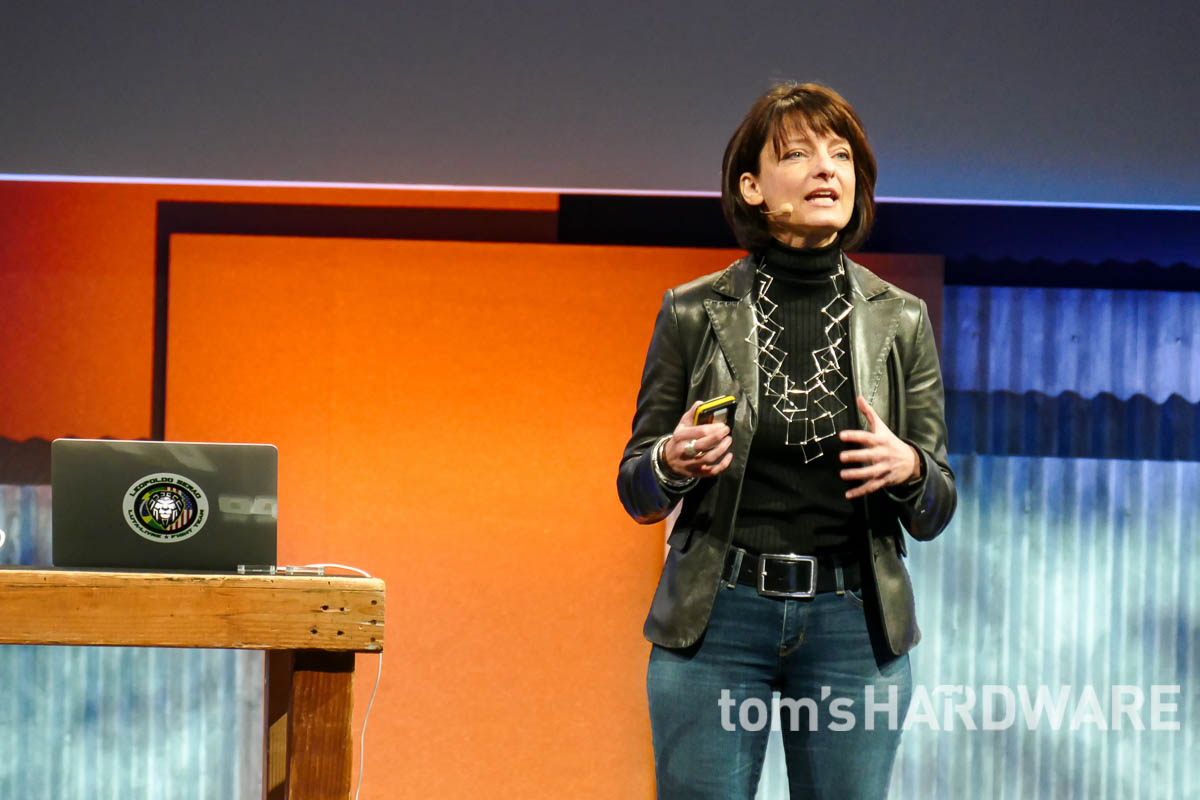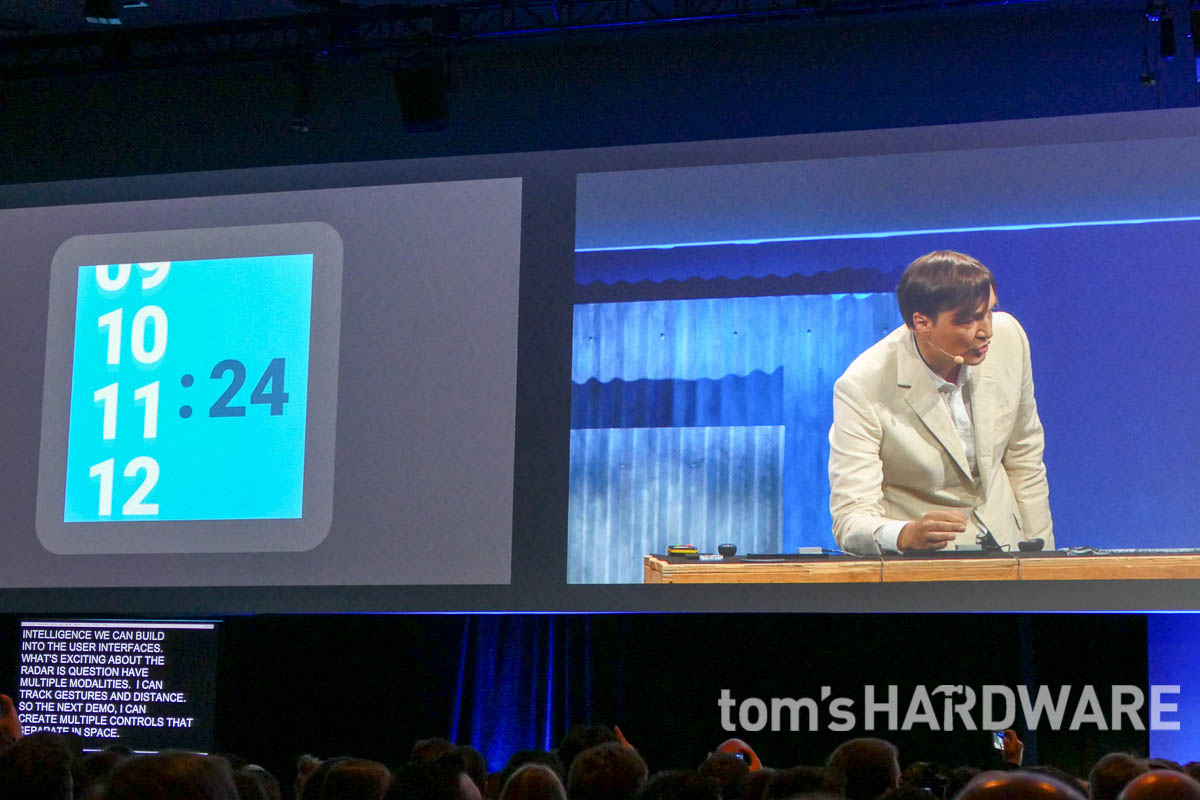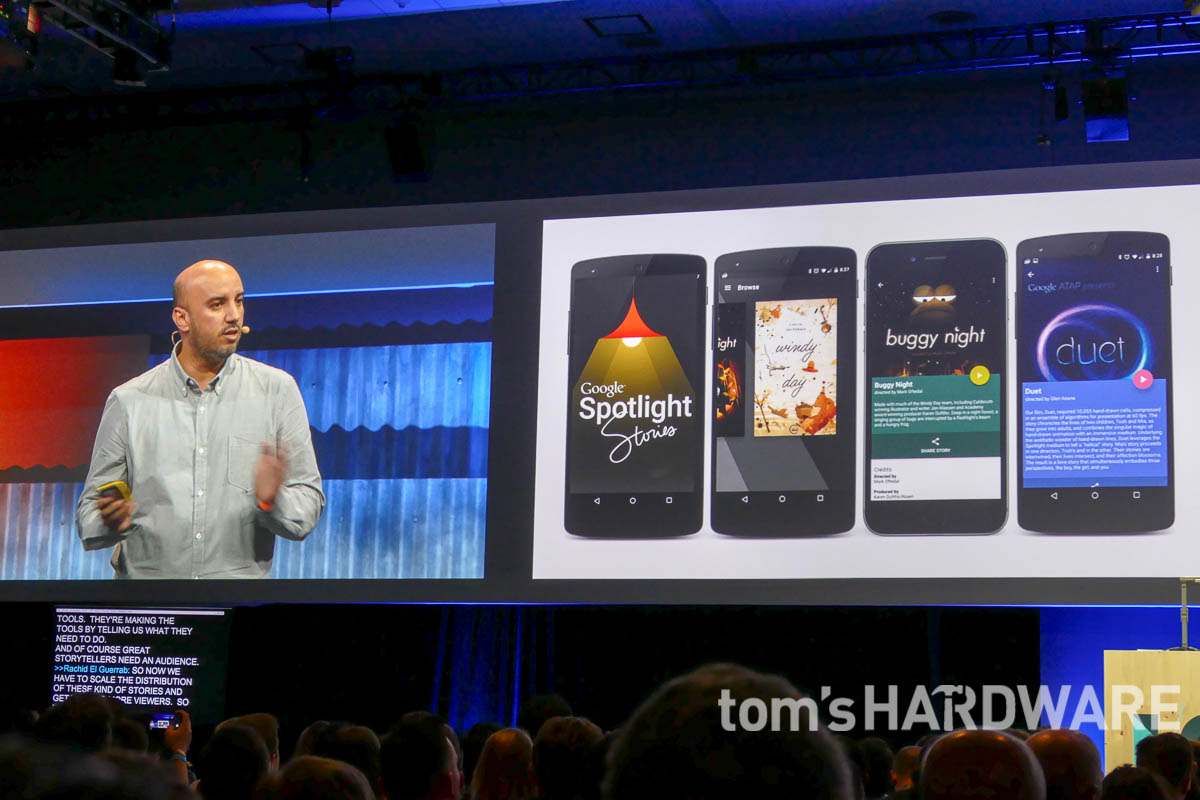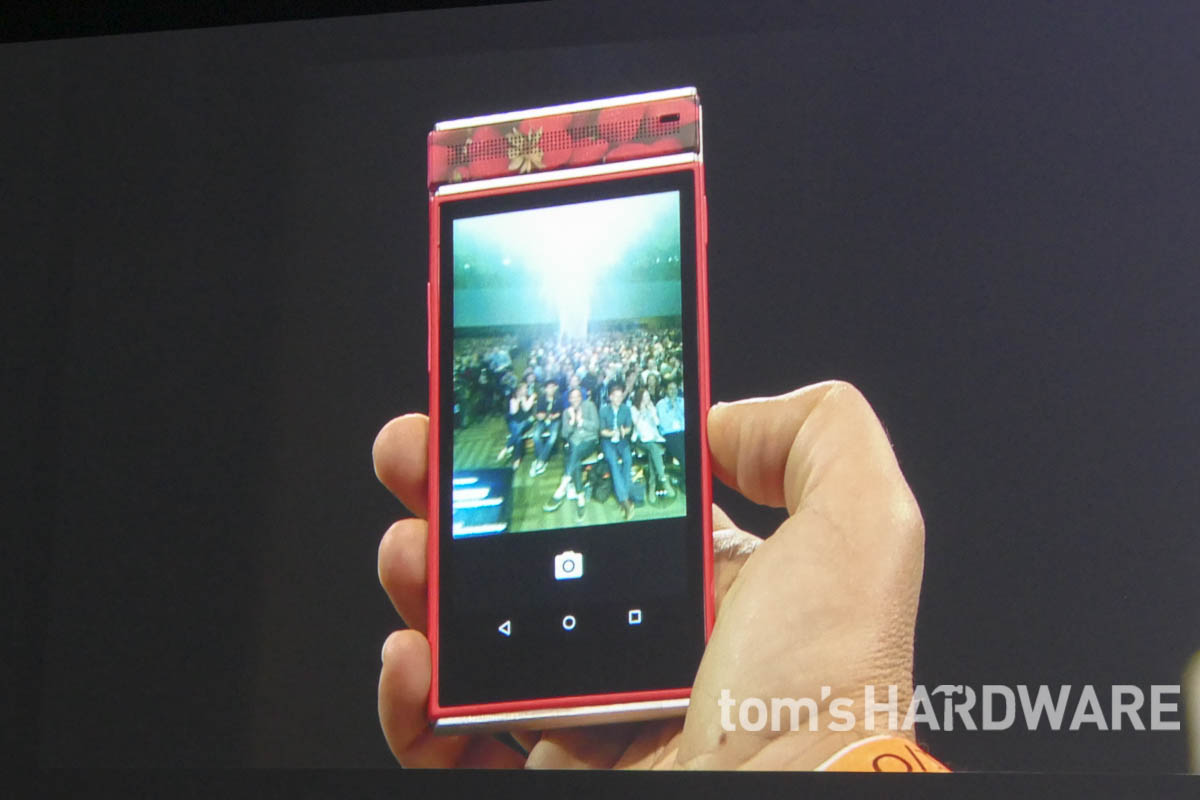Google's ATAP At I/O: Fully Functioning Project Ara Smartphone, Secure MicroSD Computer, Interactive Clothing

Google's Advanced Technology and Products (ATAP) team is well-known for its constant development of futuristic products, perhaps most notably Project Ara, a smartphone with detachable modular parts. At this year's Google I/O, the team, led by former DARPA head Regina Dugan, not only showed off a little bit more about Project Ara, but a plethora of other projects that live up to the group's namesake.
Making Touch A Little Better
The first two projects shown were new initiatives dealing with overcoming the challenges of smaller screens, specifically on wearable devices. Considering the different sizes of people's fingers, combined with the interface on a smartwatch or similar-sized device, there's not a lot of surface area to see what you're actually tapping or swiping on the screen. Not only that, but there's the added challenge of trying to detect even the most minute of hand gestures and make it work on multiple devices. ATAP tried to change that through Projects Soli and Jacquard.

Project Soli solves the problem by reducing a radar sensor to a small chip. By sending a signal towards the hand, it can capture even the slightest hand movements in the form of waves in the radar. Jamie Lien, the lead research engineer for Project Soli, and ATAP Technical Program Lead Ivan Poupyrev, showed more in-depth demos of Project Soli. Lien showed the feature through doppler, IQ, and spectogram sensors, which showed that the radar could also detect the distance of the hand from the sensor as well as the speed of the hand's movements.
Poupyrev's demo was a bit more interesting. He rubbed his index finger and thumb against each other, but the radar depicted it on screen as him turning a small dial. (Editor's note: Strongly resisting the urge to make a "world's smallest violin" joke.) He also demonstrated how it measured the sensitivity of his movements by moving a ball at different speeds around the circle. Tying in with Lien's demo of distance, he ended with showing the same hand movements to change the hours and minutes on a digital clock. He moved the hand closer to the sensor to change hours, and then moved it farther from the radar to change the minutes.
While Project Soli deals with interaction on a small scale, Project Jacquard deals with a large scope of interaction, specifically with textiles. The initial challenge was finding conductive strands of yarn. Unfortunately, there was only one kind of available yarn at the time, and it came in one bland color: gray.
Because of this limitation, the team had to find other ways to incorporate conductive yarn in a variety of options. The result is that Google partnered with textile manufacturers to make its own conductive threads in multiple colors, which allows the company to make fashionable clothing that also works with your entire hand for interaction.
A small chip is placed in a tiny pocket in the piece of clothing that interacts with a wearable device. It's an interesting development, and we'll likely see more interaction with other devices in the coming months. For now, it has serious legs, especially with a partnership with Levi's, which is sure to raise Project Jacquard's profile.
Get Tom's Hardware's best news and in-depth reviews, straight to your inbox.
Increasing Security
Future products aren't all fun and games, however, and after showing Projects Soli and Jacquard, the team went on to security in the form of two more areas of development: Project Abacus and Project Vault. The former deals with the idea of eliminating traditional security methods such as passwords and pins, while the the latter is a completely secure computer in a very small form factor.
The findings of Project Abacus are from Google's collaboration with over 30 universities in the United States and around the world. The backbone of the project is the replacement of passwords and pins, which can be easily exploited, to something more unique to the user such as the way they type on the device's keyboard.
A quick demo showed two university students testing a prototype of Project Abacus. The device uses a so-called "Trust Score" that determines if the right user is typing on the keyboard. Overall, the entire thing seems to be in its early stages, with no indication as to when we'll see more about it, but early results look promising.

On the other hand, Project Vault is perhaps a more interesting idea. Shown by hacker-turned-security expert Peiter "Mudge" Zatko, Project Vault is a fully secure computer tucked away in a tiny microSD card. The system works with any computer, but the computer's operating system won't interfere with Project Vault, making it a completely independent system with a suite of cryptographic services.
The full specs weren't revealed, but we know it contains an ARM processor, an NFC chip and antenna, and 4 GB of sealed storage. Ironically, Vault is a fully open-source device, so it should be interesting to see what others can do to make it even more secure. For now, the team will aim Vault at enterprise customers before making it fully available to the rest of the public.
Mobile Entertainment
The focus then shifted to mobile entertainment and how ATAP is bringing Hollywood-like productions to the mobile scene through what it calls Spotlight Stories. Led by ATAP's Rachid El Guerrab, the presentation showed the launch of a story development kit (SDK, anyone?) which included a story editor that allows the director to activate certain parts of their story when the camera faces a certain direction in the shift, and the ability to have modeling tools on mobile showing at 60 frames per second.
Storyboarding is also another important part in the product process, and Spotlight Stories is putting it in the digital world. The way it works is that the user draws multiple storyboards on the mobile device. Those boards are then spread in a digital plane, and your phone acts as a window to that plane so you only see the storyboards "in front" of you.

ATAP also collaborated with well-known director Justin Lin to create the first 360-degree live action video on Spotlight Stories. To accomplish this, a special camera was created that could capture all 360 degrees of a certain shot. However, any mobile device would have difficulty displaying every single frame at the same time, so the ATAP folks created spacial tiling.
Just like the storyboards, you can pan the mobile device as your own camera 360 degrees and see a specific angle of the shot without any stuttering during playback. Another implemented feature is a subtle tracker in the mobile device's screen so you know where the action is located at any point in the movie.
Spotlight Stories was initially available only on Motorola devices such as the Moto X and Moto G, which makes sense because ATAP was originally a part of Motorola Mobility before Google sold a portion of it to Lenovo. Now that's changed, and Spotlight Stories is available on any Android device. It will also be coming soon to iOS and will make its summer debut on YouTube mobile.
One More Thing
With time dwindling in the event, the team saved the best for last: another look at Project Ara. We know, we've been on this ride before, but this time it was different because we saw a fully operational version of the modular smartphone.
ATAP's Rafa Camargo initially showed and inserted a few modular pieces, such as two speakers, the battery and the application processor. He then booted the phone and we finally saw the all-too-familiar Android logo.

However, there was a camera piece missing from the modules. Without turning off the device, Camargo inserted the camera module and took a picture of the crowd. This version of Project Ara was running with the latest version of Android, and obviously there's more work to be done, but if they're able to show off a fully functioning device, it won't be too long until we hear of a release date.
Wrapping Up
One thing we didn't hear about was Project Tango, which was essentially an augmented reality program that could also track the motion of the device used through its camera, gyroscope and accelerometer. However, Qualcomm released a press statement after the event that said Project Tango would utilize its Snapdragon 810 Processor.
It's been an exciting year for ATAP, and these projects show that the team is hard at work in varying areas of the tech industry. For now we'll have to wait and see how these new endeavors, coupled with Projects Ara and Tango, pan out in terms of development and eventual release.
Follow Rexly Peñaflorida II @Heirdeux. Follow us @tomshardware, on Facebook and on Google+.
Rexly Peñaflorida is a freelance writer for Tom's Hardware covering topics such as computer hardware, video games, and general technology news.
-
tntom Really excited about how well project ara is looking. I know it will be much bulkier than a sleek integrated flagship but I would not mind.Reply -
ZolaIII "Ironically, Vault is a fully open-source device" nothing ironic about it more eyes see better besides everyone can see for them self their is no back door's. Their whare some microcontrollers recently with hardware encryption accelerators & really cheap prices... I wonder did they pick them? They are even suited for IOT.Reply -
scolaner Reply"Ironically, Vault is a fully open-source device" nothing ironic about it more eyes see better besides everyone can see for them self their is no back door's. Their whare some microcontrollers recently with hardware encryption accelerators & really cheap prices... I wonder did they pick them? They are even suited for IOT.
Vault...open. Just a little joke. :)
-
alextheblue ReplyReally excited about how well project ara is looking. I know it will be much bulkier than a sleek integrated flagship but I would not mind.
I'd rather have something a bit sleeker in this form factor since it's going in a pocket. Anything tablet sized or bigger I wouldn't care as much - I had always wished whitebooks had taken off. Anyway, what about durability? If you drop it, does it resemble a lego accident? If not, how is it secured together? Screws? Clips? A big "case" that binds it all together? (I hate cases.)

